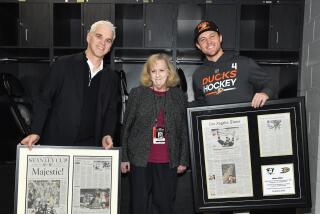Pioneering sports journalist
When the men of America went off to fight in World War II, the sports editor at the Twin City Sentinel in Winston-Salem, N.C., went with them. Mary Garber, a sports fan growing up, stepped in and took his place. When he returned from the war, he reclaimed his job and Garber returned to her pre-war assignment on the society pages.
But she wasn’t done with sports. The newspaper’s editors decided she knew more about football and basketball than she did about fashion, and in 1946 they moved her back to the sports department. She continued to report on athletics for more than 40 years, paving the way for hundreds of female sportswriters.
Garber, the only woman to win sports journalism’s highest honor, the Red Smith Award given annually by the Associated Press Sports Editors, died Sunday afternoon at a retirement home in Winston-Salem. She was 92.
Miss Mary, as she was known in Winston-Salem, worked as a full-time sportswriter at the Sentinel and then the Winston-Salem Journal until 1986, when she was required to retire at age 70. She worked part time until 2002.
In 2005 she received the Red Smith Award, which since 1981 has been given annually for major contributions to sports journalism. Previous winners include the late Times columnist Jim Murray, former Times sports editor Bill Dwyre, who is now a columnist, and broadcaster Dick Schaap.
Garber wasn’t the first female sportswriter, according to David Kaszuba, an associate professor of communications at Susquehanna University in Pennsylvania who has studied those pioneering women. Most notably, Margaret Goss wrote about women’s sports for the New York Herald Tribune in the 1920s.
At a time when most women journalists covered only women’s sports or the “women’s angle,” Garber broke the mold, Kaszuba said.
“She wrote about sports very regularly, she covered both men’s and women’s sports and she had a 40- or 50-year career.”
In her early days as a sportswriter she was assigned mostly to high school sports, and she recalled running up and down the sidelines at football games wearing a skirt, in the era before pants were acceptable attire for women.
She went on to cover a wide spectrum of sports, including football, basketball, baseball, track and field, tennis, volleyball, softball, swimming and wrestling, and at recreational, high school and college levels. There were few opportunities to cover professional sporting events in North Carolina at the time, but she did write about minor league baseball, international track and field competitions, and the Davis Cup international tennis tournament.
She also routinely reported on black high schools and historically black colleges when those teams were largely ignored by mainstream newspapers.
Clarence “Big House” Gaines, who coached basketball for 47 years at Winston Salem State University before being named to the Naismith Memorial Basketball Hall of Fame, met Garber soon after he was hired as coach in 1946 and eventually they became friends.
“Nobody cared much about black players 40 years ago,” Gaines told Sports Illustrated in 2000, five years before he died. “But Miss Mary covered a lot of things that weren’t too popular. She went out of her way to see that everybody got a fair shake.”
Garber just thought it made sense to cover all of the community’s sporting events.
“When I started working in sports full time, it seemed to me that black parents were as interested in what their kids were doing as white parents were,” she said in a 1990 interview with Diane K. Gentry for the Women in Journalism oral history project of the Washington Press Club Foundation.
A modest, petite woman, Garber relied on her quiet perseverance and cheerful attitude. Her most challenging workplace issue was access. In her early years at the newspaper she was barred from press boxes and locker rooms.
In 1946, despite having proper credentials, she had to cover a Duke University football game while sitting with the coaches’ wives. The newspaper’s managing editor protested her exclusion and told the Atlantic Coast Conference athletic directors that the paper would not send any other reporter to cover their games. After that she was free to work alongside the male reporters in the press box, but the ACC Sportswriters Assn. and the Football Writers Assn. continued to deny her membership for many years.
They eventually relented, and she wound up serving as president of the ACC Sportswriters Assn. and on the board of directors for both organizations. The ACC Sportswriters Assn.’s annual award to the best female athlete in the conference is now named after Garber.
She was elected to the North Carolina Sports Hall of Fame in 1996, and in 2006 the Assn. for Women in Sports Media renamed its annual pioneer award in her honor. In 2008, Garber was inducted into the National Sportscasters and Sportswriters Assn. and Hall of Fame.
And while she encountered some difficulties working in a male-dominated field, she also found acceptance from other, more helpful colleagues and athletes. She recalled one instance from a 1940s Winston-Salem Red Sox minor league baseball game in an interview with the Women’s Sports Foundation:
“I asked the Carolina League manager for a copy of the lineup, and he sneered and kind of laughed, ‘You’re a sportswriter?’ About the same time, Bill Haywood, one of the best players in the league, walked by and said, ‘Yes she is, and she’s a darn good one,’ ” Garber said. “That manager never gave me a hard time again.”
Mary Ellen Garber was born April 19, 1916, in New York City. Her father was a contractor who moved the family to Winston-Salem in the 1920s and started a construction business.
She graduated from Hollins College in Roanoke, Va., with a degree in philosophy in 1938. Two years later she was hired as the society editor of the Winston-Salem Sentinel.
In 1942, Garber switched over to news and in 1944 moved to sports.
Garber liked to tell an anecdote that a friend witnessed in the grandstands at a soapbox derby. A young black child pointed Garber out to his friend and said, “That’s Miss Mary Garber. And she don’t care who you are or where you’re from or what you are. If you do something, she’s going to write about you.”
Garber, who never married, is survived by nieces and nephews.
--
More to Read
Go beyond the scoreboard
Get the latest on L.A.'s teams in the daily Sports Report newsletter.
You may occasionally receive promotional content from the Los Angeles Times.










